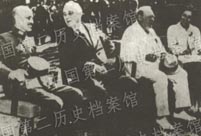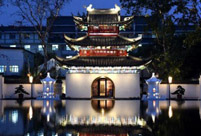 YOG kicks off in Nanjing
YOG kicks off in Nanjing
 Colorful life at Youth Olympic Village of Nanjing 2014 YOG
Colorful life at Youth Olympic Village of Nanjing 2014 YOG
 Royal Taoist temple to open to public
Royal Taoist temple to open to public
 Female soldiers at quake-hit area
Female soldiers at quake-hit area
 Shocking photos of cruel battles in Ukraine
Shocking photos of cruel battles in Ukraine
 Amphibious armored vehicle unit conducts open sea drill
Amphibious armored vehicle unit conducts open sea drill
 Water relay in Henan
Water relay in Henan
 Ethnic culture feasts eyes of travelers
Ethnic culture feasts eyes of travelers
 80 security dogs assembled in Nanjing police dog training base
80 security dogs assembled in Nanjing police dog training base
 Graffiti artists paint on street walls in Xinjiang
Graffiti artists paint on street walls in Xinjiang
North China's most polluted province Hebei claims to have abandoned obsession with mere growth, and to be focused on quality, technology upgrades and clean industry.
Beijing and Hebei have plans to invest 19.6 billion yuan (3.18 billion U.S. dollars) in a cloud computing industrial park in Zhangjiakou, a northern Hebei city 225 km from Beijing, and, after a 190 million yuan overhaul, the No.1 coal-fired unit at a Guohua Power plant in Langfang City, close to Beijing, now belches out less toxic fumes than similar gas-fired units. The plant's three other units will soon have similar makeovers.
Hebei is a major contributor to Beijing's smog and Beijing, Hebei and Tianjin, southeast of the capital, have joint strategies tackle the pollution.
The results of these efforts in Hebei have been mixed. Hebei's economic growth rate was 8.2 percent last year, but in the first half of this year, annualized growth was a mere 5.8 percent, last but one of 31 provinces and regions, beating only Heilongjiang in the northeast. Nationally, GDP expanded by 7.4 percent in the first half.
Hebei is cutting excess capacity in industries previously considered the driving force of its economy. Last year, more than 8,000 polluting factories were closed and crude steel, iron, cement and flat glass output was reduced by millions of tonnes. This year, production in these same industries is set to be cut back even further. In addition, there are plans to reduce coal consumption by 15 million tonnes.
"In the first six months, we have seen a 1.6-percentage-point increase in tertiary industries and a 1.5-percentage-point decrease in secondary industries in terms of GDP proportion," said Yang Jingxiang, deputy head of the Hebei Bureau of Statistics.
The contribution of primary and tertiary industries has increased 2.7 percentage points and 17.6 percentage points over the same period last year.
"The drop of 20.3 percentage points in secondary industry's contribution to growth comes from cuts in capacity," Yang said. Output of pig iron, crude steel and cement fell 4.8 percent, 2.9 percent and 15 percent respectively in the first half.
Industrial energy consumption also dropped by 4.9 percent, said Yang, and high-tech sectors contributed more.
There have been positive signs in terms of air quality. Eleven cities in Hebei saw 40 days of heavy pollution in the first half, seven days less than the same period last year. PM2.5 fell by 12.7 percent, according to Hebei Environment Monitoring Center. Air quality in Beijing and Tianjin also improved in the first half with more days reaching national standards over the same period last year, said the Environmental Protection Ministry.
 Eye-catching guides at the opening ceremony of YOG in Nanjing
Eye-catching guides at the opening ceremony of YOG in Nanjing A female missile launch company of PLA
A female missile launch company of PLA China, the U.S., Britain and the Soviet Union call for Japan's unconditional surrender
China, the U.S., Britain and the Soviet Union call for Japan's unconditional surrender Beautiful night scenery of Nanjing
Beautiful night scenery of Nanjing Passenger transport starts on Tibet's new railway
Passenger transport starts on Tibet's new railway Story of outstanding Beijing swat sniper
Story of outstanding Beijing swat sniper Beautiful policewoman in an anti-terrorism SWAT team
Beautiful policewoman in an anti-terrorism SWAT team Cute photos of little Taoist nuns and monks go viral online
Cute photos of little Taoist nuns and monks go viral online Photo story: How a baby panda grows up
Photo story: How a baby panda grows up Star-leveled nursing home in a small county
Star-leveled nursing home in a small county Evidence of monstrous crime of Japanese invaders
Evidence of monstrous crime of Japanese invaders Foreign models compete with Chinese in Cheongsam show
Foreign models compete with Chinese in Cheongsam show The beautiful pictures of ancient Chinese architecture
The beautiful pictures of ancient Chinese architecture The Muslims involved in relief work
The Muslims involved in relief workDay|Week|Month